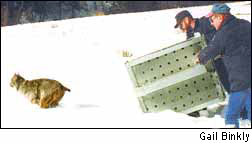March 11, 2000
BY GAIL BINKLY Management plans in national forests in Colorado and southern Wyoming must be amended to take into account effects on the Canada lynx and its habitat, Regional Forester Lyle Laverty has decided. Timber management, livestock-grazing, some recreational activities, access to backcountry areas, and the management of wildfires throughout Region 2 could be affected, said Pam Gardner, spokesperson for the U.S. Forest Service. "There may be some adjustments needed there," she said Friday in a telephone interview from Denver. Among the activities the Forest Service will be scrutinizing are any that disturb vegetation needed by the snowshoe hare, the lynx’s favorite prey, and any that tend to pack down snow. "Probably one of the areas we may be looking at that will be of the most public interest will be recreation that involves snow-compacting, such as snowmobile trails," Gardner said. The Forest Service wants to ensure that there are interconnected blocks of habitat available for the lynx and the hares where snow-compacting activities such as snowmobiling and cross-country skiing are minimized or discouraged, she said. The lynx, which is being reintroduced into Colorado under a Division of Wildlife effort, is expected imminently to be listed as either endangered or threatened by the U.S. Fish and Wildlife Service. It is already on the state’s endangered-species list. Lynx dwell in snowy, high-elevation forests and once inhabited Colorado as the southernmost portion of their range. But hunting, trapping and widespread use of poisons helped bring about their demise, biologists say. Until the reintroduction of 41 lynx into the southern San Juan Mountains last winter, the last lynx seen in Colorado was in 1973 at Vail. Seventeen of the reintroduced animals are known to have died; 15 have been tracked recently; eight are unaccounted for; and one has a radio collar that is not working. This spring, approximately 50 more lynx are to be released in the same area. Possible changes in how activities on national forests are managed will come only in areas where biologists have mapped lynx habitat, she said. "What that will mean to the San Juans specifically, I couldn’t say," she said. "That’s what the environmental analysis will do." A notice of the agency’s intent to prepare an Environmental Impact Statement will be published in the Federal Register next week, she said. Following that, the public will have 45 days to comment on the proposed action. A draft EIS is expected by July or August, she said, and the public will also be able to comment on it. Gardner said the Forest Service’s decision was not directly related either to the expected listing or to the current recovery effort. "Regardless of what the U.S. Fish and Wildlife Service decision is on that listing, we still have a responsibility to ensure that activities on national-forest lands aren’t adversely affecting the viability of the lynx," she said. "National forests are important contributors to lynx habitat in Colorado. We have a responsibility not only to lynx but to other wildlife as well." Gardner said the Forest Service supports the state’s recovery program and will be "a little ahead of the game" by starting the management adjustments now. "In my view, this is a pretty progressive step," she said. "We are going to be ahead of the other Forest Service reviews on making these management adjustments, and I’m sure the others will be watching how this evolves here and learning from our experience." |
||
Copyright © 2000 the Cortez Journal. All rights
reserved. |
